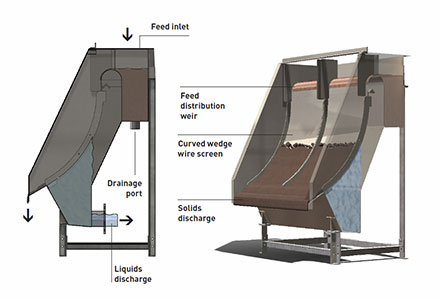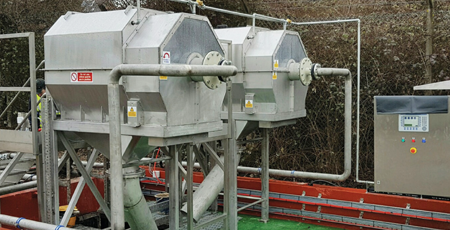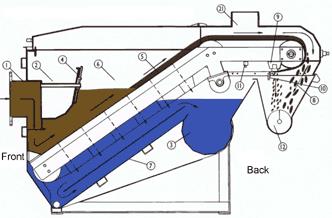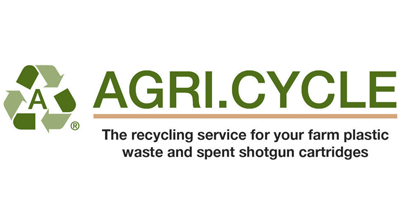Filtration
Filtration is the first stage for most of our waste water and trade effluent treatment plant designs.
The process is simple but effective and can offer great benefits.
- Removal of gross debris to protect downstream equipment
- Reduction in solids content to reduce the effects of undesirable bacteriological activity within the balancing tank
- Reduction in solids content to reduce the cost of down stream equipment that is sized according to solids loading
In summary, filtration is a high performance, low cost starting point for self treatment of waste water. It may also be improved with chemically assisted filtration – this involves the flocculation of smaller particles to make larger particles for more effective separation.
With regards to filtration, there are several options:
J-screen

- Allows filtration to 250 microns
- Physically strong – stainless steel wedge wire mesh, durable, long lasting
- Small footprint – 2m by 2m
- No moving parts
- Discharge under gravity
- Low cost
- Minimal maintenance
- Guaranteed to filter at 250 microns, cannot fail to work when operating correctly
- Requires periodic attention to remove built up debris/solids
- Has no effect on particles <50 microns

- Allows filtration to 250 microns
- Physically strong – stainless steel wedge wire mesh, durable, long lasting
- Small footprint – 2m by 2m
- No moving parts
- Discharge under gravity
- Low cost
- Minimal maintenance
- Guaranteed to filter at 250 microns, cannot fail to work when operating correctly
- Requires periodic attention to remove built up debris/solids
- Has no effect on particles <50 microns
Rotary drum screen

- Allows filtration to 250 microns
- Physically strong – stainless steel wire mesh, durable, long lasting
- Small footprint – 2m by 2m
- Only one moving part – the drum screen
- Discharge under gravity
- Low cost
- Minimal maintenance
- Guaranteed to filter at 250 microns, cannot fail to work when operating correctly
- Requires mains water flush, preferably warm to hot, once per hour
- Has no effect on particles <50 microns
Salsnes

- Kevlar weave conveyor type
- Allows filtration to 200 microns or less, cloths can be manufactured at 50 microns
- Small footprint – 2m by 2m
- Only two moving parts – the cloth conveyor and screw
- Discharge under gravity
- Minimal maintenance
- Guaranteed to filter at up to 50 microns, cannot fail to work when operating correctly
- Requires mains water flush, preferably warm to hot, once per hour
- Has no effect on particles <50 microns















